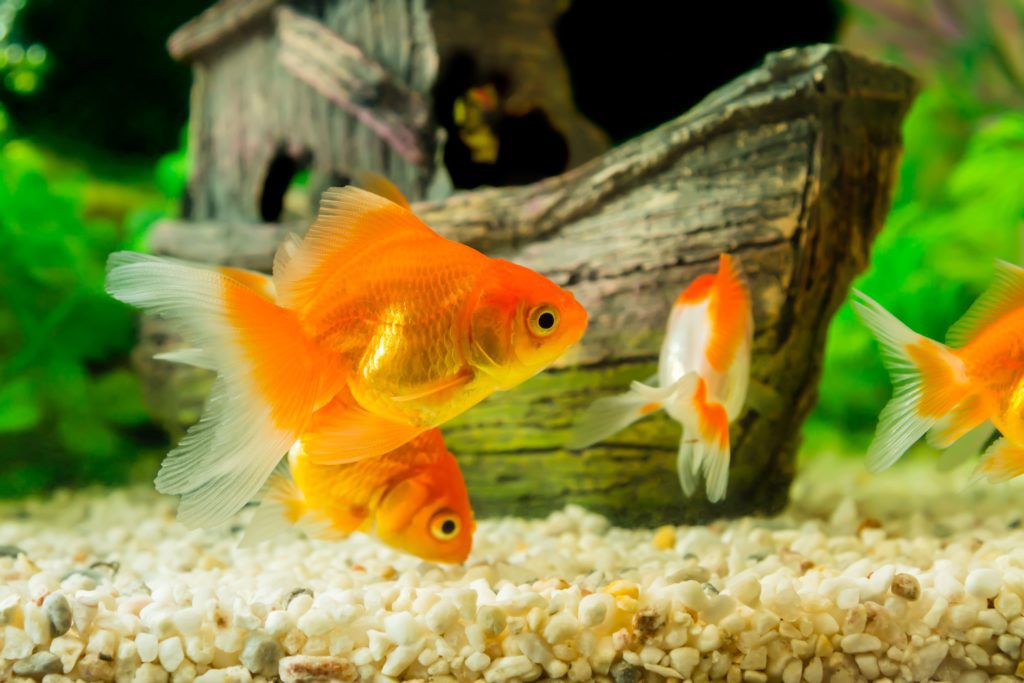For many families, fish tend to be the first pet, as they are assumed as an easy animal to look after. Once you begin to look deeper into the care that the fish will require, you may begin to notice that, contrary to belief, it is not true.
Fish can be a big responsibility to have, even though they seem relatively easy to keep. Not only are they beautiful to look at, but they are all unique and serve a different purpose in life and will require attentive and routine care, depending on the type of fish you have.
Most common fish in the UK
Goldfish:
Are one of the most common fish to which people are probably familiar with.
They are cold water fish, first bred in China over 4,500 years ago, and were brought to England in the eighteenth century and have remained the most popular of cold water pets since.
Like with most fish, the most common misinterpretation is the size and age the fish will meet. They’re known to live for up to twenty-five years and can reach over 40cm.
What size tank is required for goldfish
It is recommended that they live in a tank at least three foot long with a volume of at least twenty gallons of water.
If you plan on having more fish in the tank (only fish that can live in the same tank, typically goldfish) then you should add an extra ten gallons of water for each additional fish.
Goldfish feeding guide
It is also important to remember to not overfeed your fish, as this can lead to tank contamination as well as digestive issues within the fish
They require a small portion of flakes, 2-3 times per day, always remember to purchase appropriate food for the designated fish, as feeding the wrong fish food can also cause fatality in the fish.
Freshwater & Tropical fish
Freshwater fish originate from the rivers and lakes all across the world and live in fresh unsalted water. The species range in colour and can create a diverse and captivating environment, providing you have the required aquascape.
To suit your preference, your tank can attain many different rocks, sand and plants allowing for the fish to have a habitable environment, giving a great feel of being back in the rivers and lakes.
Tropical fish originate from the oceans and sea all across the world and live in saltwater. These species are extremely diverse, and display different behavioural traits both as individuals and groups.
You can add living plants, such as coral to these tanks, which will allow for a natural ocean feel. These plants do require a lot of attentive, specialist care however add an exquisite feel to your tank.
Fish breeds that live well together
The list can be endless to the type of fish you can get, and they all inherit different behaviours, shapes and colours. Some fish live better when in groups whilst others will dominate the tank with unsociable behaviour and will fight with their own and other species.
Before congregating fishes’ into one same tank, be sure to ask where you’re purchasing your fish from, for compatibility with sharing the tank, as stated some fish can not live amongst others due to behaviours of the fish.
As we now know, many tropical fish can live well together, these types of fishes are usually branded as “community fish” with “peaceful” attitudes
Fish that typically can live in a community tank together are:
- Catfish
- Corys
- Danios
- Gouramis
- Guppies
- Loaches
- Mollies
- Platies
- Plecos
- Rasboras
- Swordtails
- Tertas
Some of the breeds are better adapted as group fish than others.
What size tank is required for freshwater and tropical fish
As a general guide, for beginners, an aquarium of fifty-four litres or more along with a length or sixty cm or more, is suitable for these fish. This size is capable of holding a community of around fifteen to twenty small fish.
Before purchasing your tank and equipment, be sure to seek advice before purchasing your fish. The workers in charge of selling you fish will be trained and have all required knowledge on what fish can live together as well as how you will maintain your tank, such as filters, heaters and so on, as all fish have different living requirements.
Fresh water & tropical fish feeding guide
The same rule applies for most fish. Avoid overfeeding as this will cause contamination within the tank and digestive issues that can be fatal to the fish.
Feed a small amount of fish flakes 1-2 times per day.
Filling and cleaning your fish tank
As tap water contains chlorine and chloramines, you will need to treat your fish water with Tap Safe, which can be purchased from most stores, especially the one of which you will buy the fish from.
These chemicals are fatal to fish which is why it is crucial you remember to “tap safe your fishes’ tank”
Your tank should be “part changed” every two to three weeks. This means that you do not need to empty all contents of water in the tank. Leave ¼ of the water in the tank and simply fill up the remainder of the tank with clean water, as well as your tap safe, to keep those fishes safe.
Cleaning and changing your tank is vital and important not only for appearance but for the health of your fish. At least once a month, you should use an aquarium vacuum to clean the gravel and sand at the bottom of the tank, to clean any missed feces and old food, as well as a sponge to clean away any excess algae your tank may start to produce.
It is definitely worth considering adding an algae eating fish to your community tank, to help improve the cleanliness of your aquarium.
Fish feelings
It is much more difficult to notice how fish feel in comparison to other mammals, however, they definitely do have some form of emotion and can sometimes become stressed. Depending on the type, fish will show these feelings in different ways, some will viciously swim, fastly moving their tail fin, others can hide away behind rocks or inside little homes placed within the aquarium.
This is why it’s always great to ensure your fish have items in the tank that they can use for hiding and comfort.
Once you’re all set, you can enjoy the tranquility your new home aquarium has to offer!




